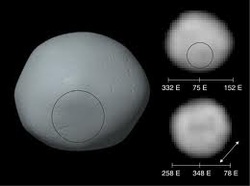
A doctoral student from the University of California has confirmed that Pallas, an asteroid lying between the orbits of mars and Jupiter, is actually a proto-planet.
Britney E. Schmidt of the Department of Earth and Space Sciences made the confirmation after studying Pallas' first high-resolution images taken using the Hubble Space Telescope. She said that Pallas is an intact proto-planet just like Vesta and Ceres, its sister asteroids.
Schmidts believes that the asteroid has been intact since the formation of the solar system some millions of years ago. She has expressed her excitement about the "new perspective on an object that is really interesting and hadn't been observed by Hubble at high resolution."
Schmidt said she and her team were not only trying to understand the asteroid itself, but also how the solar system was formed. She said that they consider large asteroids, such as Pallas, Vesta, and Ceres, "as a chance to look at planet formation frozen in time."
Hubble, in the past had tried to take pictures of Pallas but failed. It succeeded only in September 2007, giving Schmidt and her team a new understanding of the proto-planet. With the images, they were able to determine its actual shape and measure its size. They were also able to observe light and dark areas on its water-rich surface, which indicate the same internal change planets undergo.
Schmidt and her team also found a big impact site, which could explain why Pallas has a family of asteroids of its own. She said, "It's an interesting chance to almost look into the object, at the layer underneath. It's helping to unravel one of the big questions that we have about Pallas, why does it have this family.
Britney E. Schmidt of the Department of Earth and Space Sciences made the confirmation after studying Pallas' first high-resolution images taken using the Hubble Space Telescope. She said that Pallas is an intact proto-planet just like Vesta and Ceres, its sister asteroids.
Schmidts believes that the asteroid has been intact since the formation of the solar system some millions of years ago. She has expressed her excitement about the "new perspective on an object that is really interesting and hadn't been observed by Hubble at high resolution."
Schmidt said she and her team were not only trying to understand the asteroid itself, but also how the solar system was formed. She said that they consider large asteroids, such as Pallas, Vesta, and Ceres, "as a chance to look at planet formation frozen in time."
Hubble, in the past had tried to take pictures of Pallas but failed. It succeeded only in September 2007, giving Schmidt and her team a new understanding of the proto-planet. With the images, they were able to determine its actual shape and measure its size. They were also able to observe light and dark areas on its water-rich surface, which indicate the same internal change planets undergo.
Schmidt and her team also found a big impact site, which could explain why Pallas has a family of asteroids of its own. She said, "It's an interesting chance to almost look into the object, at the layer underneath. It's helping to unravel one of the big questions that we have about Pallas, why does it have this family.
 RSS Feed
RSS Feed